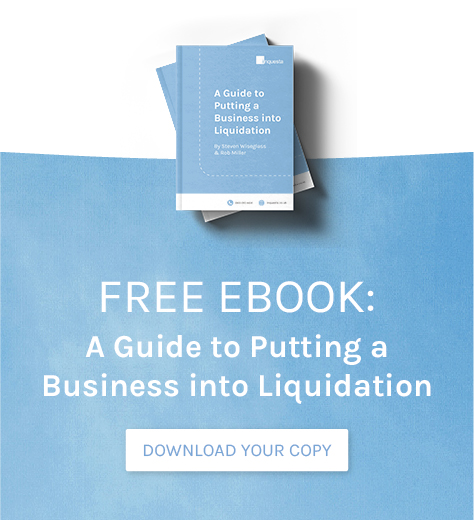Company directors bear a lot of responsibility towards shareholders in the event of a liquidation. In fact, the needs of shareholders are just one of the many things a business owner will need to consider when closing down their enterprise – including which route to go down (if they have a choice in the first place) and how to deal with employees.
Given that the liquidation process can be quite complicated, it is recommended that you seek specialist advice at your earliest possible opportunity. If you ask for guidance when the very first warning signs of trouble appear, you may even be able to reverse your financial situation and avoid the need for liquidation altogether.
Which Route has been Chosen?
A director’s responsibility towards shareholders depends largely on the method that is used to liquidate the company. There are three main ways in which a business can be closed, which are:
Compulsory Liquidation
As the name would suggest, this course of action is forced upon a business by its creditors. If they believe that you are unable to satisfy your obligations, they can petition to the Courts to have your company closed down and assets liquidated.
This process begins when your creditors apply for a Winding Up Petition, which is a request to the Crown to close down your firm. More often than not, your main creditor will be HMRC in its pursuit for unpaid taxes such as Corporation Tax, National Insurance Contributions and VAT. Other creditors, such as suppliers, can also request that your business be liquidated.
Creditors’ Voluntary Liquidation (CVL)
If your business is struggling to pay its debts, you may feel that you have no option but to liquidate the company using a CVL. A director will typically use this option in order to avoid a compulsory closure.

Members’ Voluntary Liquidation
Unlike the other two methods, this way of closing down a business is done when the company is solvent. It is extremely popular with company directors as it is the most tax-efficient way of liquidating their firm.
Responsibility Towards Shareholders – Involuntary Liquidation
If your company is closed down at the behest of your creditors, your shareholders will lose all of their influence and have no say in the proceedings. Once all the assets have been liquidated, your shareholders will be classed as unsecured creditors – meaning they are usually left at the bottom of the pile below most other creditors when it comes to receiving funds.
Because shareholders invest in companies on a risk basis, they are unfortunately unable to claim any form of compensation, remuneration, dividend or repayment of their exposure until all other creditors have been satisfied. As a result, they will usually not see anything from their investment as the company will have run out of funds before the shareholders can be compensated.
Responsibility Towards Shareholders – Voluntary Liquidation

When it comes to a voluntary liquidation, shareholders will have a lot more say in how the business is closed down. They will firstly be involved in a Shareholders Meeting at the start of the liquidation proceedings – something they are not afforded the luxury of in the case of compulsory shut downs.
If a company’s directors feel that liquidating the business is the best course of action, they must gain shareholder approval. The first task directors need to carry out is arrange a shareholder meeting. This can be done at ‘short notice’, provided 75% of shareholders (by value of shares) agree to this.
If the short notice was agreed, the shareholders meeting will take place within seven days of the notification being issued. The purpose of this is to come to two resolutions:
- Whether or not to wind up the company
- Decide on the liquidator to use
For the liquidation to take place, it must gain the approval of 75% (by value of shares) of those attending the meeting. This means that if a shareholder does not attend, they will lose their say.
Since there are usually no creditors to take care of in the case of MVLs, shareholders will retain a lot more of their power. For example, they will be able to choose which licensed insolvency practitioner to work with – unlike in cases of involuntary liquidation where it is the creditors that make this decision.

Whether or not shareholders see any form of return on their investment, however, depends largely on whether or not the business is solvent at the time of liquidation. If the company is wound down because it is unable to satisfy its debts, then its shareholders will still again be treated as unsecured creditors.
Expert Advice When You Need It
If your business is experiencing financial difficulties, you can rely on Inquesta to help. We’ve worked with companies across all areas of industry and are perfectly placed to assist you – no matter your circumstances.
Whether you are just seeing the early warning signs of financial trouble, or have reached a decision that insolvency appears to be the only solution, we will work with you to achieve the best possible outcome for you. We also understand that there is no one-size-fits-all solution, which is why we will take the time to gain a thorough understanding of your circumstances and alter our services to match.

In cases of a solvent liquidation, however, things are slightly different. Because there are usually no secured creditors to satisfy, the shareholders will in most circumstances appear at the top of the pile when it comes to remuneration.
Once HMRC has either confirmed that all outstanding liabilities have been settled, or there were no outstanding liabilities to begin with, funds from the business are released in the form of capital distributions. If an indemnity has been signed and the funds have already been released, any funds that might have been held by the insolvency practitioner can then be released.
For more information about how Inquesta can help your business, contact our team today or book a free consultation.



